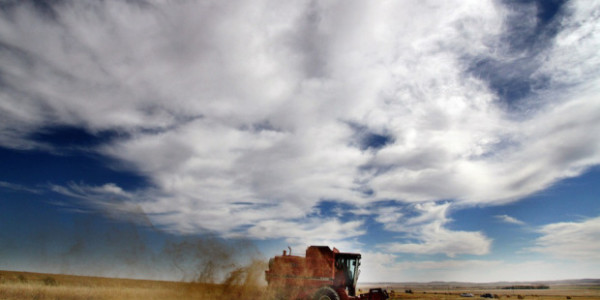Taylor Scott International News
As the world’s population swells beyond seven billion and emerging markets’ appetite for food grows, Canadian institutions are getting increasingly hungry for agribusiness and farmland acquisitions abroad. Canada’s pension funds have long been putting their money into mining, energy and infrastructure, and more recently luxury retail brands, but now many are snapping up swathes of arable land or creating special investment vehicles to explore opportunities in agriculture. “We’ve seen this uptick in interest in investing in agricultural assets, and, I think the growing importance of food production overall in the world,” says Grant Jameson, who heads up the Canadian agribusiness practice at Norton Rose Fulbright. Canadian institutions, tired of the lacklustre returns in the market, are seeking options with better yields than gold and government bonds, such as agriculture, experts say. As the global standard of living rises, so too does consumer desire for different and fresher types of food, says Jeff Barnes, a partner at Borden Ladner Gervais LLP in Toronto. “As people get more flush, one of the small luxuries is to look a little wider for their food. And that’s going to feed agribusiness.” This year, Canada Pension Plan Investment Board launched its agriculture investment program, and made its first direct farmland investment in a portfolio of U.S. farmland. “These assets have historically delivered stable risk-adjusted returns but, more importantly, the outlook in the global agricultural market in the coming decades is positive due to increasing demand for a wide variety of agricultural products as populations and incomes rise in emerging economies,” CPP’s 2013 annual report states. CPP’s initial focus will be the U.S., Canada, Australia and New Zealand, it added. Meanwhile, the Ontario Teachers’ Pension Fund at the beginning of this year created a “natural resources” investment asset class. Teachers says it will look for “new opportunities in oil and gas and agriculture.” Last year, Caisse de dépôt et placement du Québec and British Columbia Investment Management Corp. joined with U.S. financial services company TIAA-CREF to create a global agriculture investment vehicle, with $2-billion earmarked to buy farmland in the U.S., Australia and Brazil. In 2011, Alberta Investment Management Corp (AIMCo), joined a forestry management firm in a $415-million acquisition of Australian timberlands — options for which chief executive Leo de Bever said included reverting it to agriculture. Farmland, with its steadily rising prices, is a tantalizing investment option – and one that provides interim income by leasing it to agricultural operations, says Mr. Barnes. “From the point of view of the investor, you are buying the land and you’re leasing it back to a farmer so you’re getting current yield,” he says. “The long-term bet is that this is an asset that people believe will be extraordinary in terms of how much it increases in value.” Canadian farmland values have risen steadily over the last decade, according to Farm Credit Canada, but spiked last year. During the second half of 2012, prices on average rose 10%, which is the highest since the organization began tracking farmland prices in 1985. The cost of farmland across the country in 2013 is at record highs, according to real estate firm RE/MAX, with low inventory pushing up supply in 15 out of the 17 rural markets it tracks. The greatest upswings were in Saskatchewan and Alberta. For example, the price per acre in east central Saskatchewan was $850-$2,500 in 2013, up from $650-$1,250 just two years earlier, RE/MAX said. The price hikes in southwestern Ontario have been particularly steep, according to farmland appraiser Valco. The average rate of increase over 10 counties has been roughly 25% per year since 2010. Land can cost upwards of $15,000 per acre. Farmland values across the globe between 2002 and 2010 have risen up to 1,800%, according to the Global Farmland Index compiled by U.K.-based real estate firm Savil. The biggest upswings have been in emerging markets, such as Romania and Hungary, it said. But the fact that prices have escalated so rapidly is a problem for potential investors, says AIMCo’s Mr. de Bever. He wonders whether the investment potential for farmland has run its course. He explains that the rationale for investing in land is that, with rising demand for protein in the Far East, existing landstock will become more valuable. Yet he points out that land values operate on a long cycle, and that the recent run up in value has been compressed into a short timeframe. “It’s not clear to me that any increase in farm prices is going to be rewarded with an appropriate return.” Still, Mr. de Bever says AIMCO, and other investors, will keep an eye out for farmland acquisitions — albeit a cautious one. “My guess is that there is still going to be quite a bit of demand. My concern is that I would be very picky and make sure that you’re buying right.” Mr. Barnes expects Saskatchewan to remain attractive, where land parcels are larger and the prices are a bit better. Australia remains attractive too, given the similarity in governing structures, compared to places with more instability such as Africa, he says. Other factors that will influence future demand include the trend of using technology to convert unsuitable land into arable land, in parts of South America, Mr. de Bever says. Some parts of Africa will emerge as better investment possibilities once they stabilize politically. “It is one of the areas where you will for the next while see a lot of growth,” Mr. Barnes says. “Whether it will be ticked with pluses and minuses, I don’t know. But it’s certainly an area that is very much in the front of peoples’ minds, especially since other hard commodities like metals are not so much in the front of their mind right now.” Financial Post Taylor Scott International
Taylor Scott International, Taylor Scott








